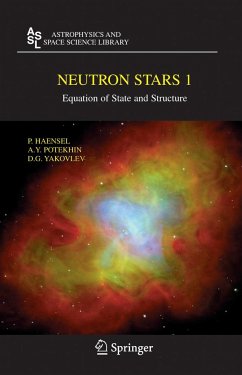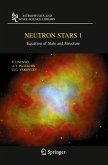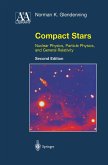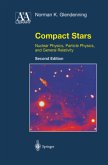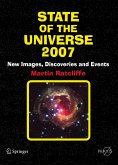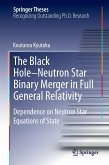- Overview
- Equilibrium Plasma Properties Outer Envelopes
- Structure and EOS of Neutron Star Crusts
- Envelopes with Strong Magnetic Fields
- Neutron Star Cores: Nucleons and Hyperons
- Neutron Star Structure
- Neutron Stars with Exotic Cores
- Strange Matter and Strange Stars
- Theory Versus Observations
- Appendices
- Bibliography
- List of Symbols
- List of Abbreviations
- Subject Index.
Neutron stars play a unique role in physics and astrophysics. On the one hand, they contain matter under extreme physical conditions, and their theories are based on risky and far extrapolations of what we consider reliable physical theories of the structure of matter tested in laboratory. On the other hand, their observationsoffertheuniqueopportunitytotestthesetheories. Moreover, n- tronstarsareimportantdramaticpersonaeonthestageofmodernastrophysics; they participate in many astronomical phenomena. ?3 Neutronstarscontainthematterofdensityrangingfromafew g cm attheir 15 ?3 surface, where the pressure is small, to more than 10 gcm at the center, 36 ?2 wherethepressureexceeds10 dyncm . Tocalculateneutronstarstructure, one needs the dependence of the pressure on density, the so called equation of state (EOS), in this huge density range, taking due account of temperature, 9 more than10 K in young neutron stars, and magnetic ?elds, sometimes above 15 10 G. The present book is mainly devoted to the theory of the EOS of neutron star matter and its consequences for neutron star structure. As one moves from the neutron star surface to the center, the methods to calculate the EOS change. Atomic structure and plasma theories are used for the surface stellar layers. Deeper layers of the neutron star crust require nuclear theory combined with plasma physics, both in very exotic density-temperature regimes. Finally, the neutron star core necessitates many-body theory of dense strongly interacting systems,togetherwiththephysicsofstronginteractionsofelementaryparticles.
- Equilibrium Plasma Properties Outer Envelopes
- Structure and EOS of Neutron Star Crusts
- Envelopes with Strong Magnetic Fields
- Neutron Star Cores: Nucleons and Hyperons
- Neutron Star Structure
- Neutron Stars with Exotic Cores
- Strange Matter and Strange Stars
- Theory Versus Observations
- Appendices
- Bibliography
- List of Symbols
- List of Abbreviations
- Subject Index.
Neutron stars play a unique role in physics and astrophysics. On the one hand, they contain matter under extreme physical conditions, and their theories are based on risky and far extrapolations of what we consider reliable physical theories of the structure of matter tested in laboratory. On the other hand, their observationsoffertheuniqueopportunitytotestthesetheories. Moreover, n- tronstarsareimportantdramaticpersonaeonthestageofmodernastrophysics; they participate in many astronomical phenomena. ?3 Neutronstarscontainthematterofdensityrangingfromafew g cm attheir 15 ?3 surface, where the pressure is small, to more than 10 gcm at the center, 36 ?2 wherethepressureexceeds10 dyncm . Tocalculateneutronstarstructure, one needs the dependence of the pressure on density, the so called equation of state (EOS), in this huge density range, taking due account of temperature, 9 more than10 K in young neutron stars, and magnetic ?elds, sometimes above 15 10 G. The present book is mainly devoted to the theory of the EOS of neutron star matter and its consequences for neutron star structure. As one moves from the neutron star surface to the center, the methods to calculate the EOS change. Atomic structure and plasma theories are used for the surface stellar layers. Deeper layers of the neutron star crust require nuclear theory combined with plasma physics, both in very exotic density-temperature regimes. Finally, the neutron star core necessitates many-body theory of dense strongly interacting systems,togetherwiththephysicsofstronginteractionsofelementaryparticles.

